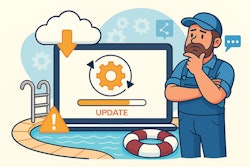
There are plenty of ways that AI can benefit a pool and spa business; that was the core message of Pam Vinje’s seminar at the International Pool | Spa | Patio Expo in Dallas. Whether it’s in your advertising or in the ability to offload tedious tasks and free up your own time for more important things, AI is getting better and more relevant every day. Techniques for implementing it into your everyday processes are only growing — so don’t be afraid of it, Vinje emphasizes in her seminar. Harness it instead.
REORGANIZING, RESTRUCTURING, REDOING
Vinje, who’s been on the cutting edge of digital marketing in the pool and spa industry since she launched her agency, Small Screen Producer, in 2009, says that “artificial intelligence is being baked into everything we’re doing.”
But what does this mean for your business? Big or small, you can’t risk falling behind the trends and losing out on potential customers, potential ad space, or the opportunity to make your business more efficient. (Of course, in the world of the internet, it can feel impossible to keep up with the ever-changing demands of consumer audiences and the content they consume.)
“Companies have to reinvent themselves every 13 seconds,” Vinje jests. “We’ve gone through so much evolution with technology. First it was regular websites, then mobile sites, and then apps like Facebook, Instagram and now Tiktok — constant reorganization, restructuring, redoing.”
Barring hyperbole, it does feel like the landscape of technology and thus how companies should be using it changes daily, if not even more frequently. For the consumer, it’s much easier to follow the whims of digital marketing, internet trends and the burgeoning use of AI. But for businesses of all sizes, the need for change comes at breakneck speed — with the expectation that you’re both ahead of current trends and engaging in them.
This can be hard to block out when it comes to deciphering which parts of AI can serve your business better (what good does an AI summary do if your customers will have to read the full article for that one piece of information anyway?), but Vinje presented a clean breakdown of three types of AI processes and ways you can use them to your advantage. From helping you set calendar events to assisting your advertising through search engines, there’s plenty of space for AI to help your burgeoning business.
MODELS, AGENTS, PROMPTS
When it comes to understanding AI, one of the most important things is to swallow the big lump that rises in your throat when you see how overwhelming it can be. Outside of industry-specific needs, it feels like AI is everywhere, especially in places you wouldn’t expect. Some of the largest platforms you might recognize are Microsoft Copilot, Google Gemini and the ever-controversial ChatGPT.
But Vinje identifies AI as three main components: models, agents and prompts. Broken into bite-size pieces, you have a better chance at digesting which parts of AI can be most effective for your business.
MODELS
ChatGPT is an example of an AI model, which is defined as the engine on which agents and prompts run, according to Vinje. You’ll recognize AI models as the predictive analytics, or the chatbots you use when trying to troubleshoot an issue. Or maybe you’re more familiar with the recommendations that streaming services like Netflix show you each time you sign in — analyzing past movie choices and learning to display similar choices for your next movie night.
However familiar you are with AI models, it goes without saying how much they can assist you in daily tasks. Models are trained to recognize certain patterns and make particular decisions without any assistance from human users, all based on a set of data. This is why chatbots work: After the initial training phase, they come to understand the most likely outcomes of conversations or the most probable desired results of certain procedures. This way, AI models can complete tasks and assist you without so much as lifting a finger.
AGENTS
An AI agent is a little more specific in its processing. Instead of being used for data processing and prediction like models are, agents are trained to make decisions based on interactions with users over time. This means that specific tasks can be taught and thus completed much more quickly after a period of time.
Whether this is the creation of images, videos, or something more complex like reading financial documents, AI agents have plenty of opportunities for use in a business setting.
Businesses most commonly use AI agents for customer service and virtual assistance, Vinje says. “There’s an autonomy that’s gained through the use of AI agents. We can and should use it to our advantage."
Do your customers need assistance when browsing your website? Is your team currently too small to accommodate this need? Consider training AI to help you fill this void. Assist your customers and devote your time to something else.
PROMPTS
AI prompts are perhaps the easiest to understand, as it’s exactly what it sounds like: an instruction that users give to AI agents and models, telling it exactly what to do. In many instances, the use of AI prompts will look like a conversation between the user and whichever software is being used.
For example, imagine you need a description written for a product, service, or event that your company is advertising. With the use of AI prompts, the stress of the blank page can be instantly remedied by simply asking it to write you a description. The more specific the instruction, the nearer to perfection the output will be. At the very least, prompts for written outputs can give you a starting point before you edit it yourself to get the desired result.
With a baseline knowledge of the three main components of generative AI, Vinje begins to unravel the overwhelming mess of using it in advertising, both the ways businesses can use it to their advantage as well as potential concerns that should be kept in mind as the world of AI evolves.
USING AI IN YOUR DAILY AGENDA
For Vinje, the value she places in her team has had a major shift over the last few years. “It’s easy to feel like you become your tasks while at work, or that your entire job is hinged on these administrative tasks that we do every day,” she says, “but that’s not the case.”
If you strip away the responsibility of your most tedious tasks, where does that leave you?
The answer is simply put: You and your team can be left to pursue the more intensive requirements of your job without worrying about the back and forth of smaller things.
“We’re not giving up our brain power to AI,” Vinje reassures her audience. “They’re our assistants. My prediction is that we’ll move to a commonly used business model of artificial intelligence plus automation plus human intelligence. We understand nuances much better than AI, but there’s no reason not to use it as an assistant.”
With an automated workflow, things like setting calendar events, drafting simple emails and monitoring customer support avenues can be less of a headache and open up your day to do more for your business.
TREAD CAREFULLY: ADVERTISING WITH AI
Specifically in the advertising sphere, Vinje recommends caution and recognizes the need for further refinement over the coming years. With AI overviews on search engines like Google, new issues are beginning to emerge, one of them being the apparent invisibility of industry-specific websites behind more mainstream brands.
Vinje referenced a particular experiment where she tried conducting an online search for what the internet claimed to be the best hot tubs on the market. Expecting to find particular brands in the industry, she was surprised to find the AI-generated overview of the search results had nothing of the kind.
“It didn’t name any brands in our industry,” she explains. “Instead, I was shown a list of non-industry brands, like Wayfair and Home Depot.”
What’s more, Vinje says, is that many times just trying to get an ad campaign listed on a search engine is as difficult as searching for them after the fact. AI models will flag and reject several ads due to the unfamiliarity it has with certain industry-specific terms.
Which begs the question, she confirms: “How do we submit ads to search engines if AI is going to get in our way like this?”
Until AI has the power to learn more about smaller industries, advertising could prove to be a struggle.
LOOKING AHEAD
It’s hard to exist in today’s world without hearing AI referred to in both positive and negative lights, but as Vinje suggests, there’s no way around it — for better or worse, AI is here to stay. It will only get better. The best thing for now is to learn how to use it to your advantage, and see your business thrive as we enter the age of artificial intelligence.
“We’re allowing AI to be our assistants,” Vinje reminds her audience. “With this on our side, AI has the power to make us both more productive and scalable in the long run.”
This article first appeared in the February 2025 issue of AQUA Magazine — the top resource for retailers, builders and service pros in the pool and spa industry. Subscriptions to the print magazine are free to all industry professionals. Click here to subscribe.












































